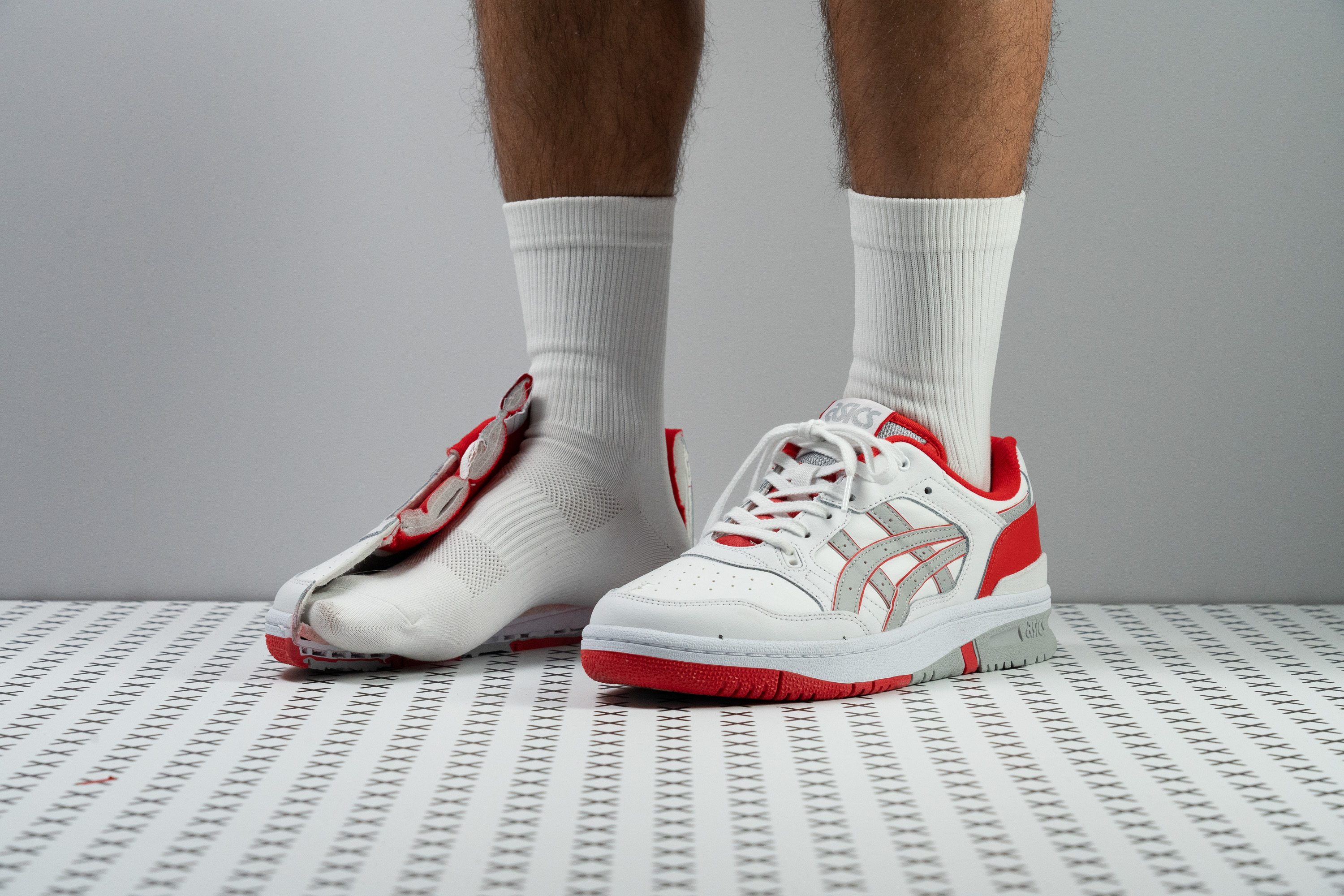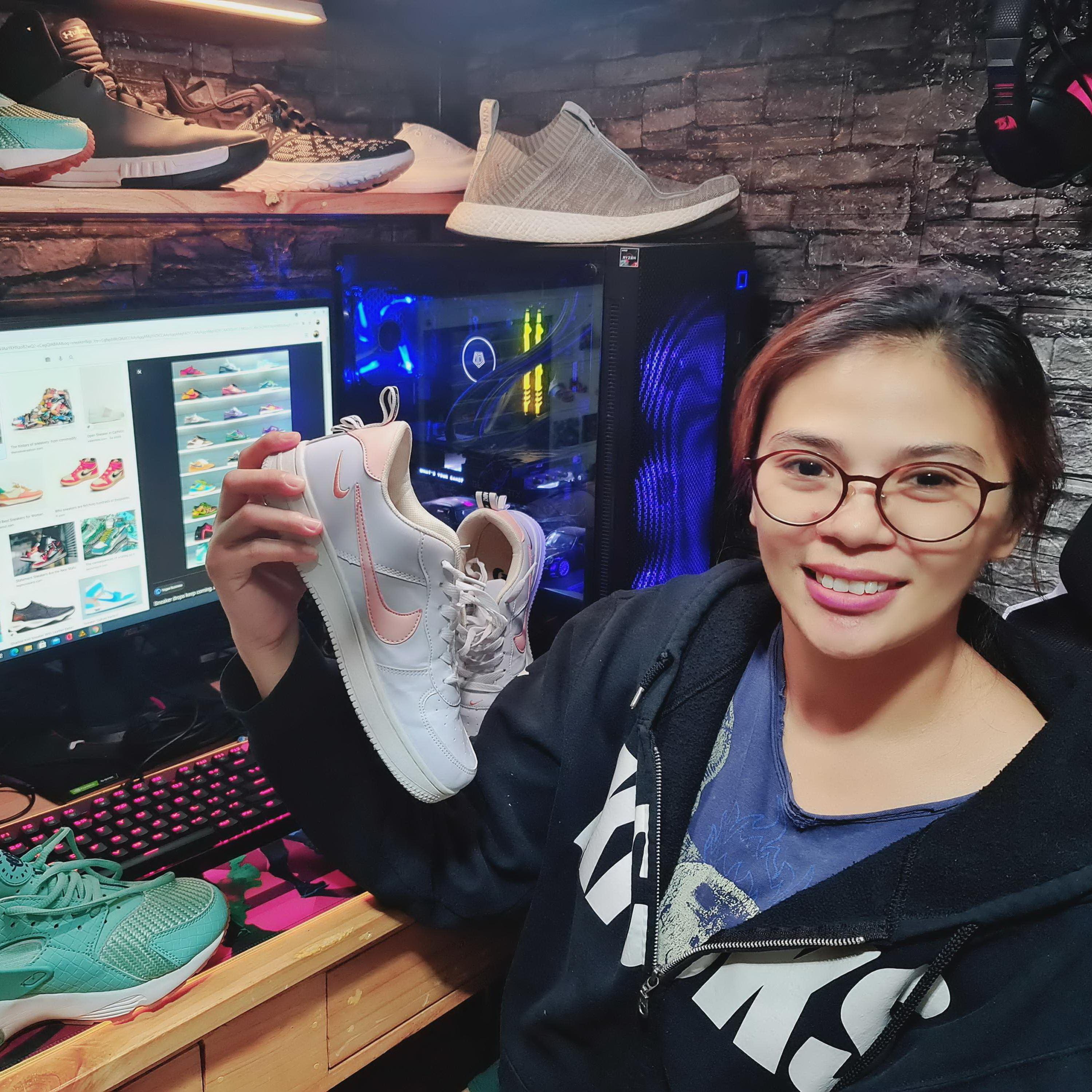Our verdict
- Top pick in best basketball sneakers
Pros
- Keeps feet warm
- Great traction even on wet surfaces
- Extremely comfy
- Good impact protection
- Feels stable underfoot
- Retro look
- Completes many casual outfits
- Good for gym days or some fitness activities
- Easy to clean
- Has Ortholite insoles
- Fits true to size
Cons
- Quite heavy
- Toebox needs a bit of break-in
- Some synthetic material in the upper
Audience verdict
Comparison
The most similar sneakers compared
+ + Add a shoe | |||||
|---|---|---|---|---|---|
| Audience score | 91 Great! | 94 Superb! | 91 Great! | 96 Superb! | |
| Price | $110 | $110 | $125 | $125 | |
| Style | ClassicRetroSporty | RetroSporty | ClassicRetroSporty | PlatformRetroSporty | |
| Shock absorption | - | - | Low | Moderate | |
| Energy return | - | - | Low | Moderate | |
| Traction | - | - | High | Moderate | |
| Breathability | Warm | Moderate | Warm | Moderate | |
| Weight lab | 17 oz / 482g | 16.4 oz / 465g | 14.5 oz / 411g | 16.8 oz / 476g | |
| Size | True to size | True to size | True to size | True to size | |
| Midsole softness | Balanced | Balanced | Balanced | Balanced | |
| Material | Leather | Leather | Cup SoleLeather | Cup SoleLeather | |
| Season | Winter | SpringFall | SpringFall | SpringFall | |
| Inspired from | Basketball | Basketball | Basketball | Basketball | |
| Width / fit | Medium | Medium | Medium | Narrow | |
| Toebox width | Medium | Medium | Medium | Narrow | |
| Leather/suede quality | Real leather | Real leather | Real leather | Real leather | |
| Toebox durability | Good | Good | Decent | Decent | |
| Heel padding durability | Good | Decent | Decent | Bad | |
| Outsole durability | Good | Decent | Good | Bad | |
| Heel stack lab | 30.1 mm | 27.0 mm | 22.9 mm | 36.7 mm | |
| Stiffness | Stiff | Stiff | Moderate | Stiff | |
| Tongue padding | Average | Average | Average | Average | |
| Drop lab | 11.8 mm | 12.5 mm | 11.1 mm | 16.6 mm | |
| Forefoot | 18.3 mm | 14.5 mm | 11.8 mm | 20.1 mm | |
| Removable insole | ✓ | ✓ | ✓ | ✓ | |
| Heel tab | None | None | None | None | |
| Torsional rigidity | Stiff | Moderate | Moderate | Stiff | |
| Heel counter stiffness | Stiff | Stiff | Stiff | Stiff | |
| Closure | Laces | LacesVelcro | Laces | Laces | |
| Top | Low top | Low top | Low top | Low top | |
| Ranking | #53 Top 44% | #19 Top 16% | #57 Top 48% | #3 Top 3% | |
| Popularity | #94 Bottom 22% | #63 Bottom 47% | #36 Top 30% | #8 Top 7% |
Who should buy
We recommend the ASICS EX89 as an excellent choice for:
- Retro basketball shoe fans looking for a nostalgic kick that's been revamped with modern comforts
- Style-minded individuals who want a timeless white sneaker with many color accent options to choose from
- Those in the market for a well-padded and nicely cushioned shoe that's good for getting our daily steps in
- Active individuals who prioritize stability and traction for gym days or hitting the court for some basketball
- Those looking for a versatile and comfy shoe that won't break the bank
- People living in cooler climates who want a sneaker that will keep their feet warm
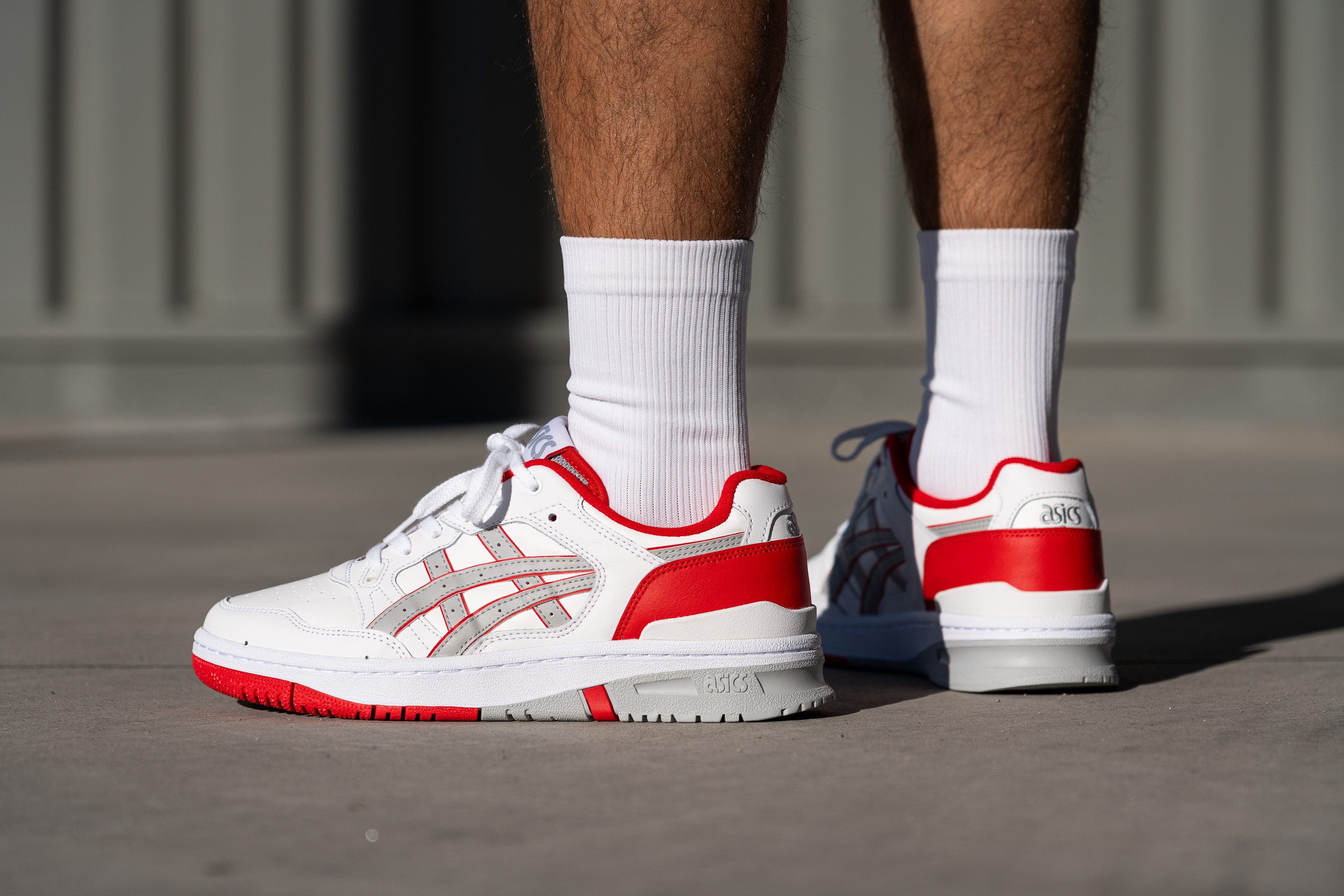
Who should NOT buy
At 17 oz (482g), the EX89 is quite heavy for a sneaker. Even most basketball shoes are about 3 oz (80g) lighter based on our current lab average. The ASICS Gel Lyte III is a lighter basketball-inspired alternative that has a more retro-futurist look.
ASICS incorporates a mix of leather and synthetic materials in the EX89's upper as a means of keeping the price fairly low. For those who prefer more premium materials without paying much more, we recommend checking out the all-leather New Balance 550.
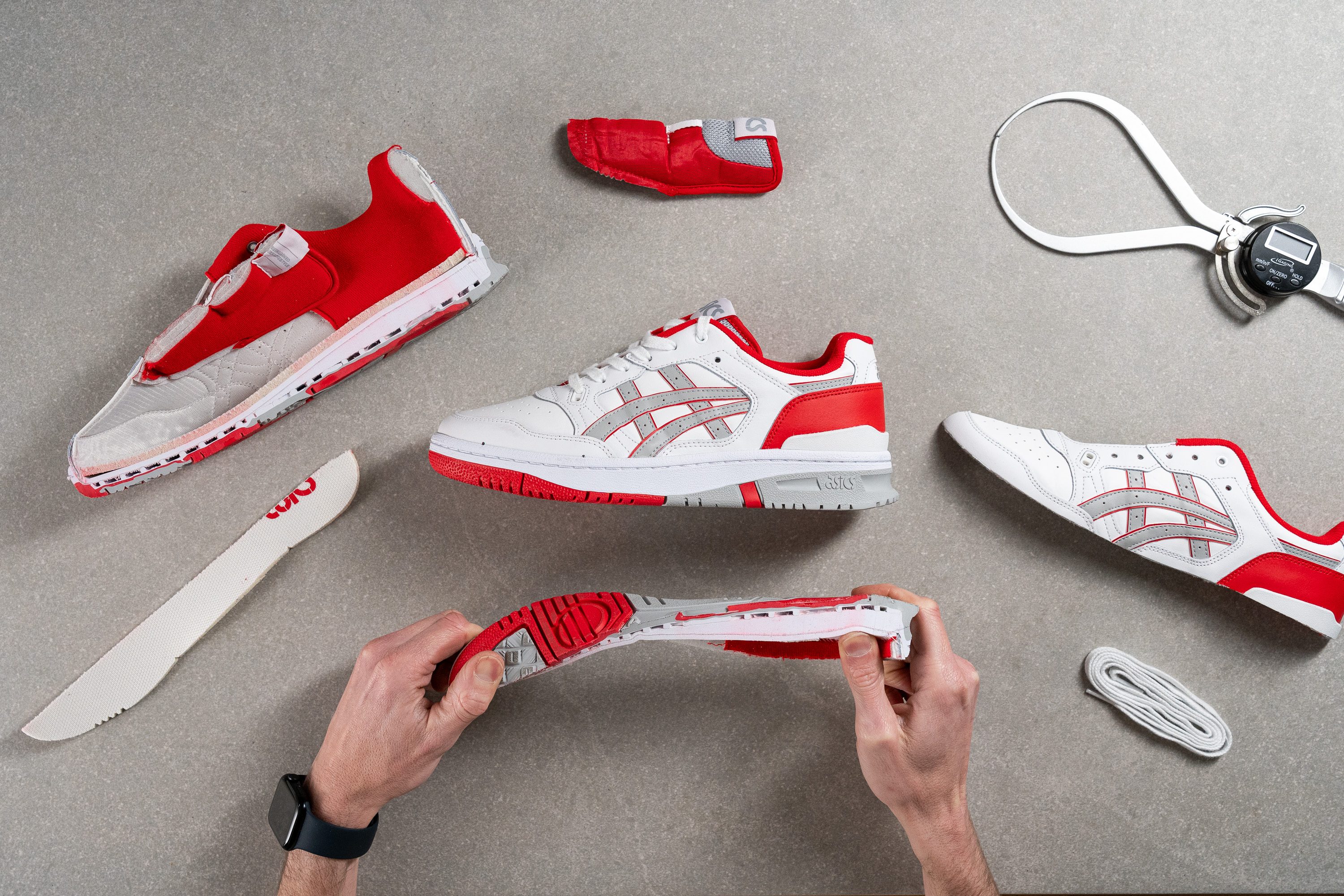
Cushioning
Heel stack
The EX89's heel stack is just shy of our current lab average at 30.1 mm thick according to our caliper measurements.
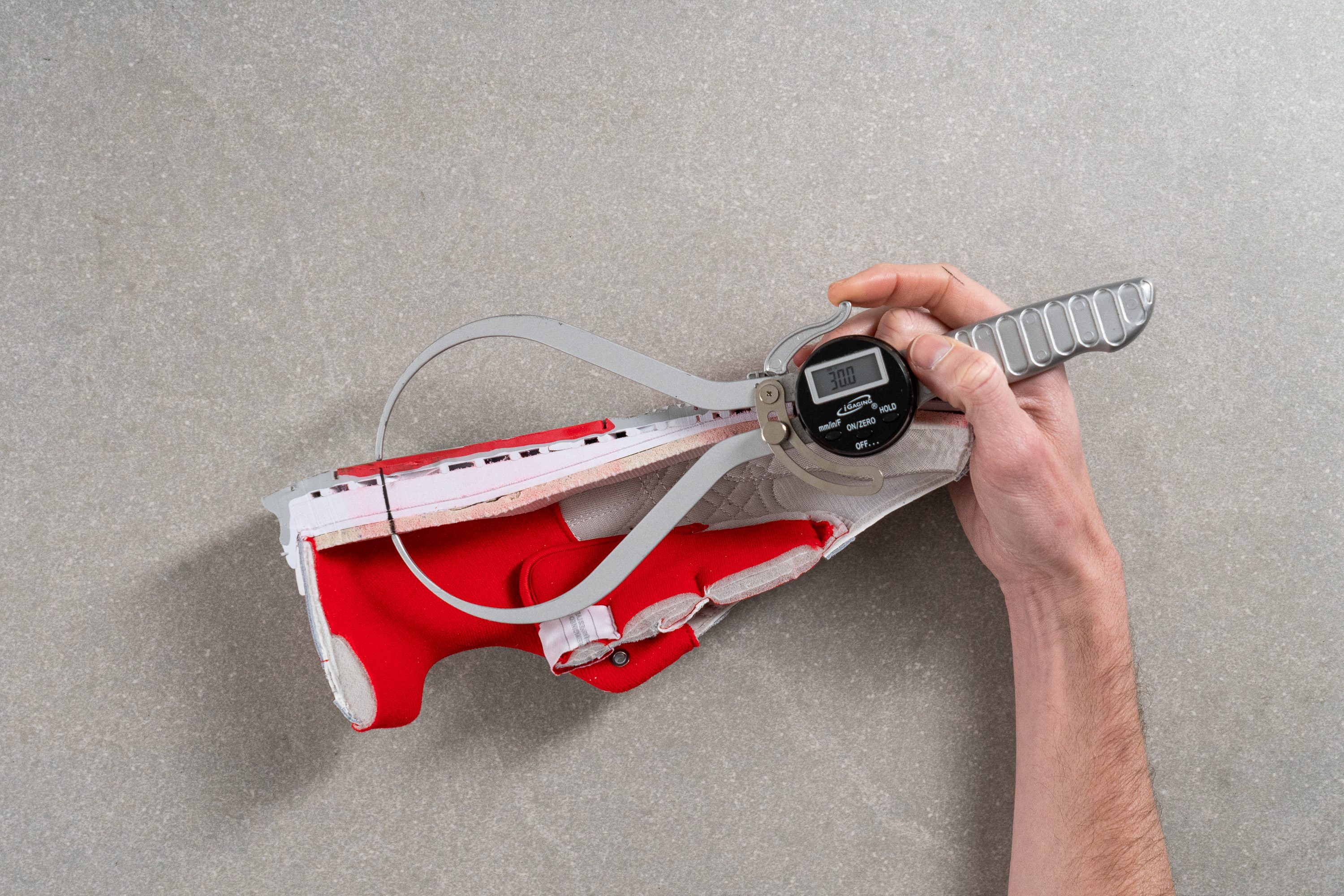
This is a good amount of foam underfoot to effectively cushion our landings for a protective and comfy ride despite the shoe's somewhat firm feel underfoot. The little air pockets between the midsole and outsole also contribute to the shoe's shock-absorbing ability.
| Asics EX89 | 30.1 mm |
| Average | 30.7 mm |
Forefoot stack
We measured the forefoot stack to be 18.3 mm thick which is also shy of our current lab average.

Having such a low profile in the front gives us lots of ground feel for intuitive toe-offs while still leaving us with enough cushioning material underfoot.
| Asics EX89 | 18.3 mm |
| Average | 19.5 mm |
Drop
The difference in our stack measurements leaves the EX89 with a drop of 11.8 mm. This is on par with the average for sneakers and should feel quite natural for most as it presents a good mix of an elevated and protected heel with a more grounded and stable forefoot.

| Asics EX89 | 11.8 mm |
| Average | 11.2 mm |
Midsole softness
The biggest update to this iconic shoe is the inclusion of ASICS' FF Blast technology in the midsole. It feels somewhat firm as the foam doesn't compress very much under our weight. Despite this, however, the shoe does have a nice and comfy ride as we tested over the course of a normal day.
Seeking an explanation, we pressed our durometer against the FF Blast midsole and got a softer-than-average reading of 25 HA. This level of softness indicates a balanced level of cushioning, with the shoe's initial firm feeling likely coming as a result of the hard and beefy outsole.
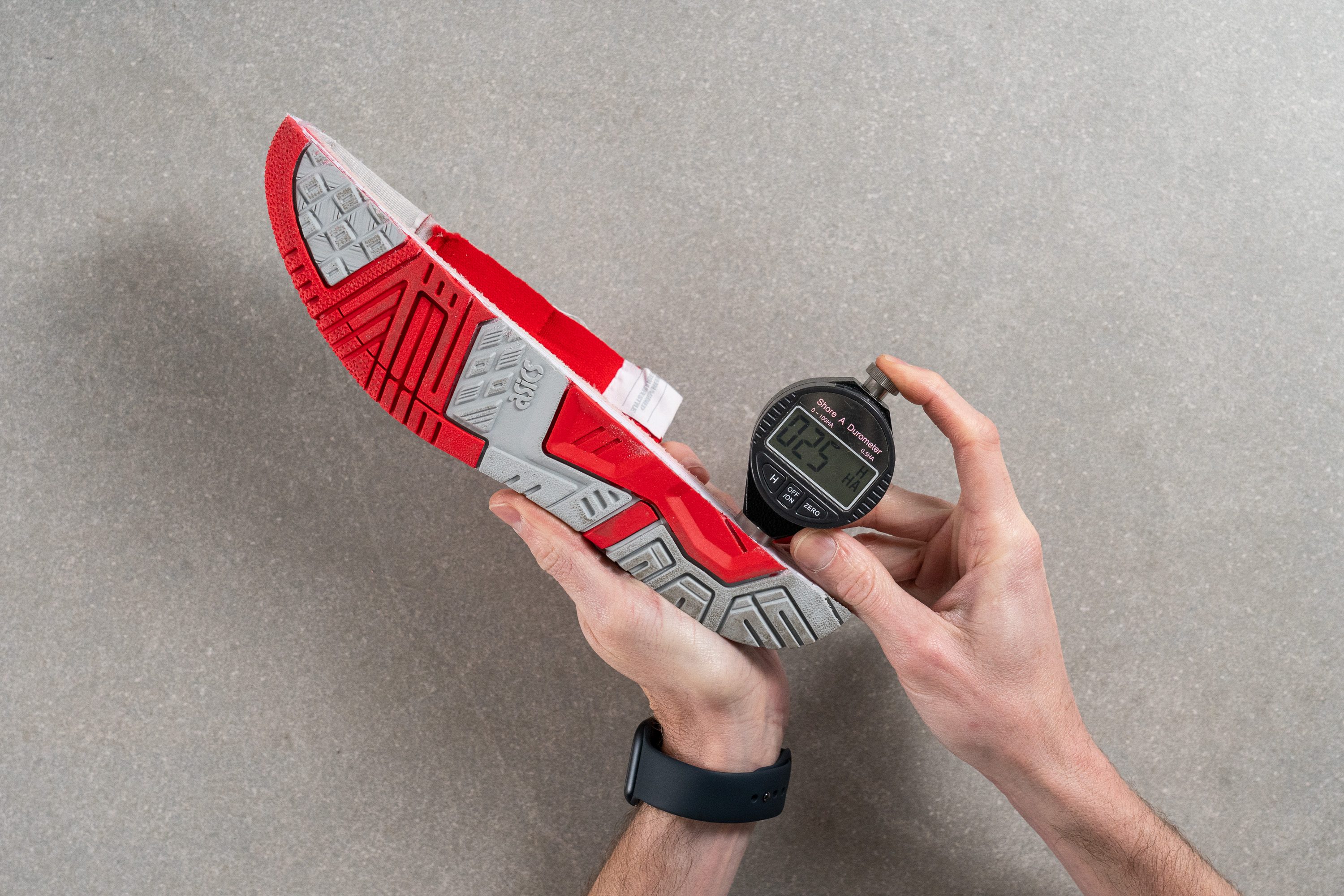
| Asics EX89 | 25.0 HA |
| Average | 28.6 HA |
Size and fit
Size
Asics EX89 fits true to size (58 votes).
Width / Fit
Using our caliper, we measured the EX89's toebox to be 99.5 mm wide at its widest point. This is on par with our current lab average making it a roomy enough option to provide a good fit for most people.
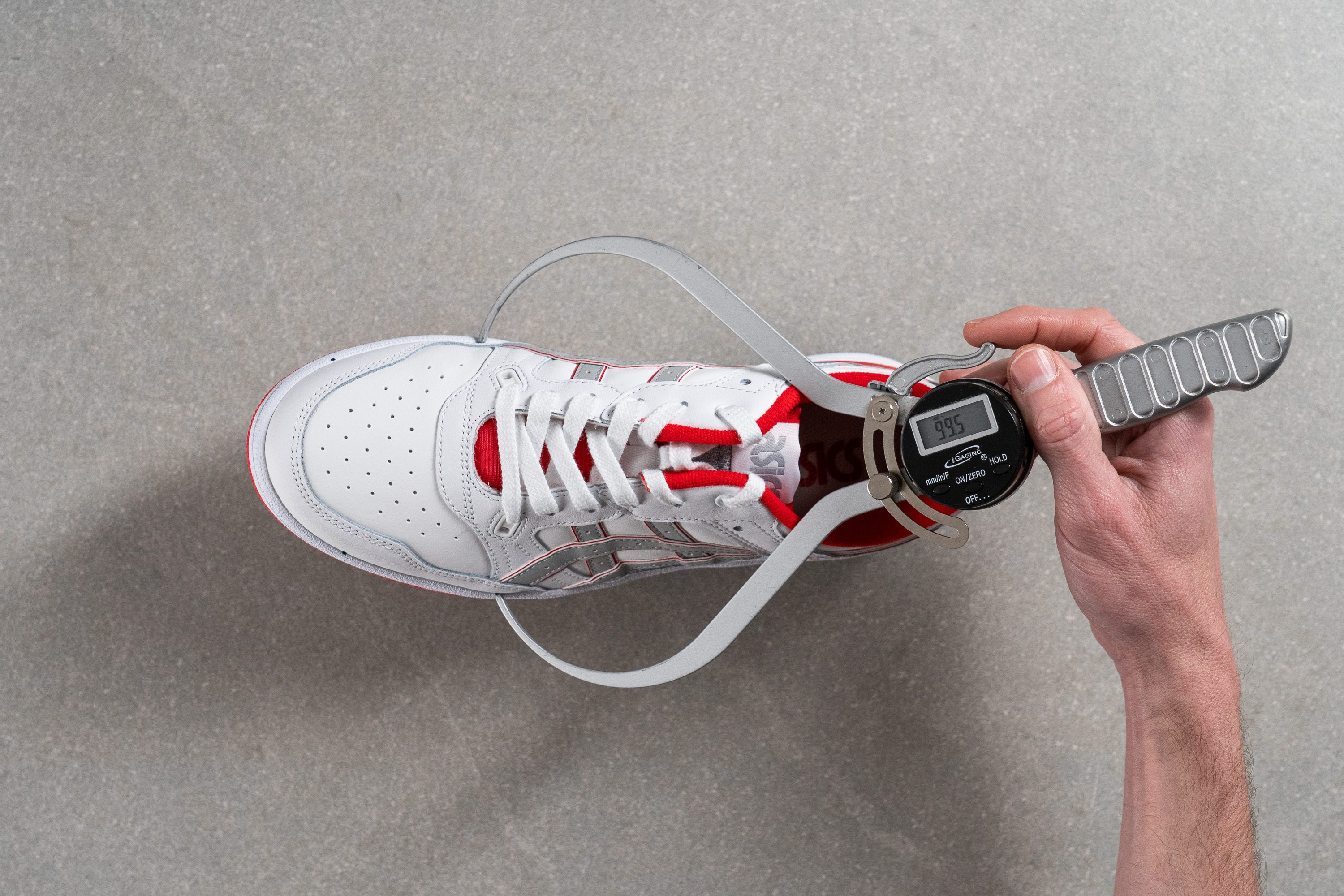
This test follows an older methodology, which is why you don't see recently tested shoes in the chart. Results from different methodologies can not be compared.
| Asics EX89 | 99.5 mm |
| Average | 99.0 mm |
Toebox width
The EX89's toebox tapers to 75.7 mm wide at the big toe according to our caliper measurements. This also falls in line with our current lab average and means that it should accommodate most people's feet quite comfortably.
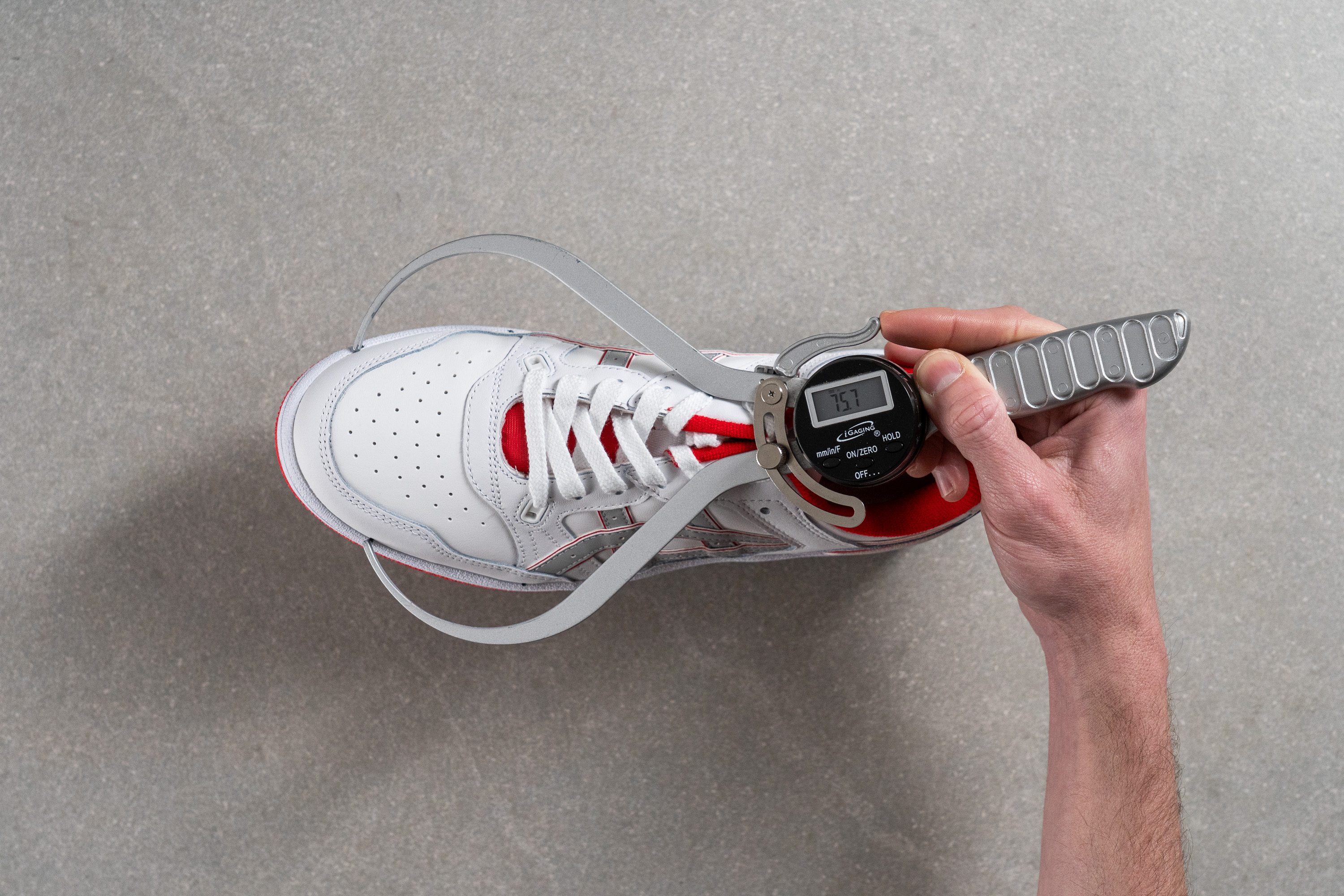
For those with very broad feet of a certain shape that need a little more room to splay out without butting up against the sidewalls, we recommend the ASICS Gel 1130 as a roomier alternative.

This test follows an older methodology, which is why you don't see recently tested shoes in the chart. Results from different methodologies can not be compared.
| Asics EX89 | 75.7 mm |
| Average | 75.0 mm |
Flexibility / Stiffness
We secured the shoe to our workbench and found that 30.2N of force is needed to bend the shoe to 90 degrees. This is a stiffer result than average and means that the EX89 is relatively resistant to the natural flexion of our foot.
While this does sacrifice a little comfort from its ride, this level of stiffness does help with the kick's supportive and stable sensation. However, those who prefer a shoe that's more flexible and natural-feeling underfoot should look into the NB 480 as an alternative.
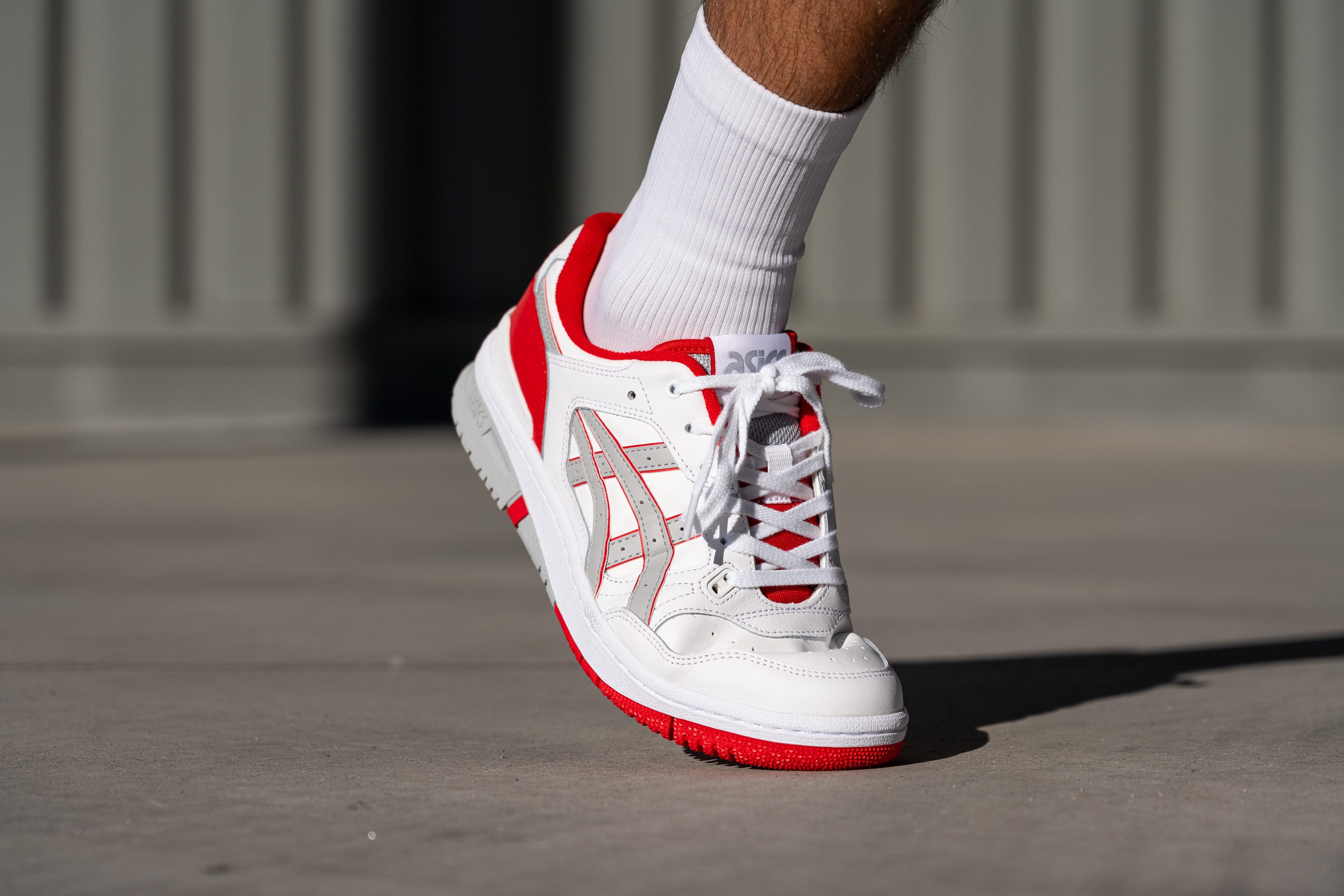
This test follows an older methodology, which is why you don't see recently tested shoes in the chart. Results from different methodologies can not be compared.
| Asics EX89 | 30.2N |
| Average | 23.3N |
Weight
The EX89 tips our scale at a hefty 17 oz (482g) which is significantly heavier than our current lab average for sneakers. As such, it's quite beefy underfoot as we stomp around town, with the weight feeling a little more pronounced when we take on fitness activities. It does still feel quite good at the gym or for quick basketball games.

For those who prefer a lightweight kick that feels swift and nimble underfoot, we recommend checking out the ASICS Gel Lyte III instead.
| Asics EX89 | 17.0 oz (482g) |
| Average | 13.8 oz (390g) |
Breathability
Despite the little pores in the toebox, the smoke we pumped into the shoe wasn't able to filter out of the EX89 except in thin wisps through the tongue. This lackluster performance is typical of leather sneakers and earns the EX89 the lowest breathability score of 1 out of 5. So while this shoe will feel nice and cozy in the winter or on a brisk evening, it's of a sweatbox come summertime.
When we examine a backlit cross-section of the EX-89's upper, we can see that the light does manage to shine through those little perforations while the rest of the shoe blacks it out entirely. This leads us to think that the shoe should have performed a little better in our smoke test as there are quite a few pores dotting the toebox and sides of the shoe.
Turning to our microscope for answers, we can see that the holes don't go all the way through, with a thin mesh internal lining forming a barrier to airflow. This explains the shoe's lackluster ventilation despite being well-perforated. Apart from being toasty, it also means that the EX89 runs the risk of developing an odor over time, especially if used for physical activities.
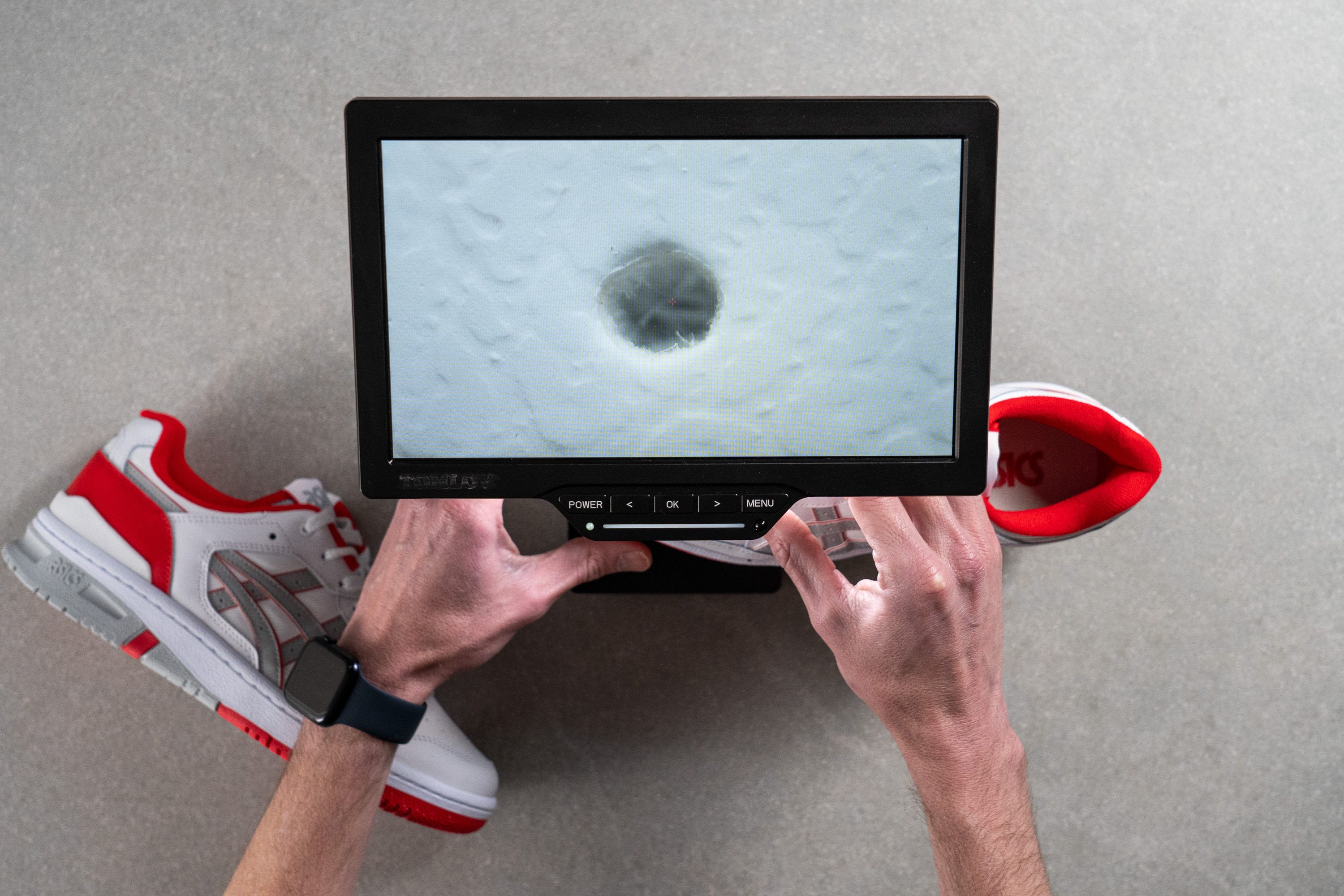
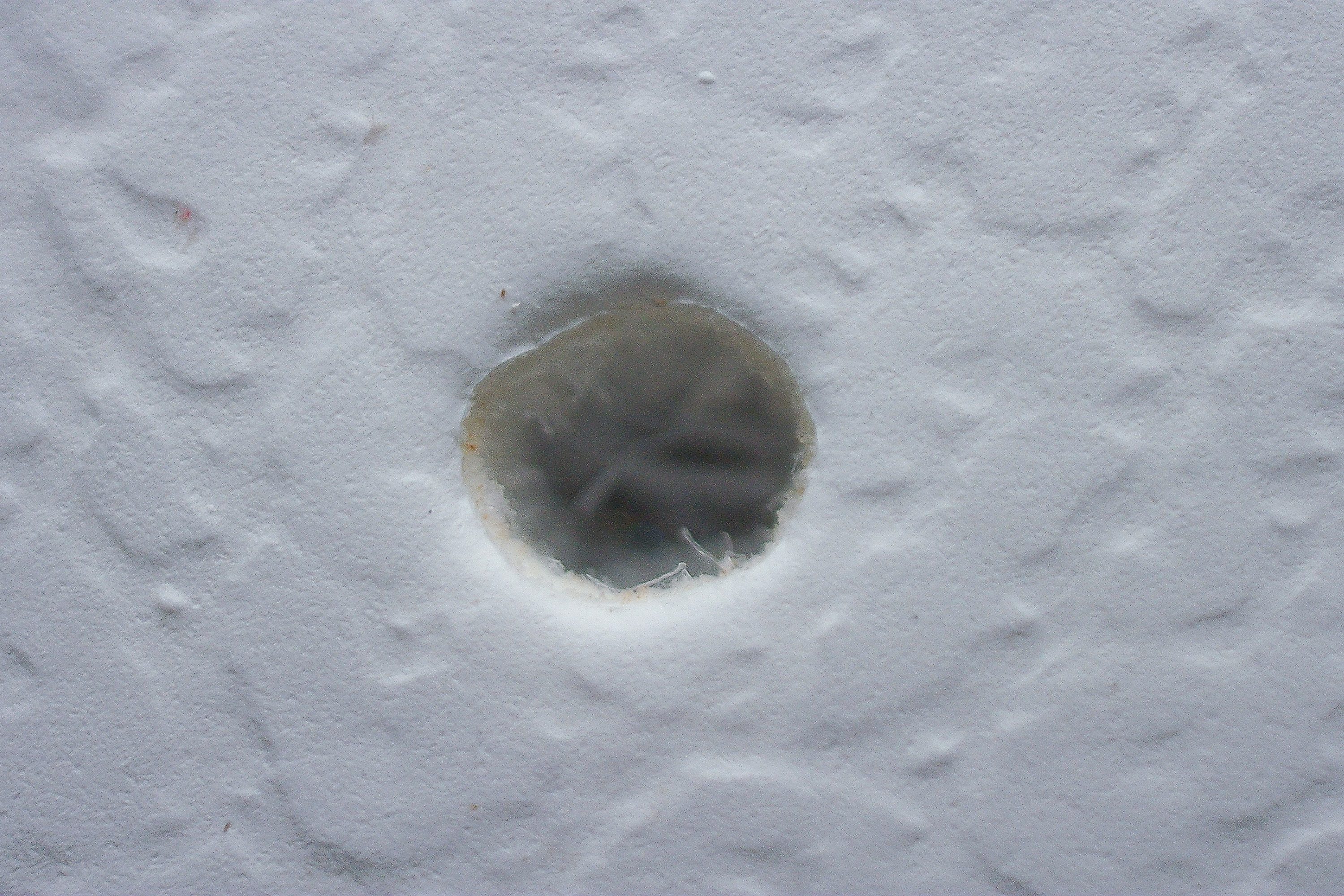
| Asics EX89 | 1 |
| Average | 3 |
Stability
Lateral stability test
As previously mentioned, with its low forefoot stack, the EX89 feels very well-grounded as we go about our day-to-day activities. This stable ride also comes as a result of a number of features that we'll explore below.
Torsional rigidity
The EX89 boasts a very high level of torsional rigidity that we scored a 5 out of 5 in our manual assessment. As such, the EX89 resists the natural twisting and lateral movements of our foot and maintains a level platform that promotes steady landings.
| Asics EX89 | 5 |
| Average | 3.6 |
Heel counter stiffness
The heel counter is also very stiff, earning another maximum score of 5 out of 5 on our subjective scale. This mitigates excessive lateral movements at the rearfoot which, combined with the high torsional rigidity, makes the EX89 a good option for those with overpronating strides.
| Asics EX89 | 5 |
| Average | 3.2 |
Midsole width - forefoot
We measured the EX89's midsole to be 107.8 mm wide at the forefoot which is just shy of our current lab average. This is still more than enough of a platform that we didn't have any stability issues while testing the shoe.
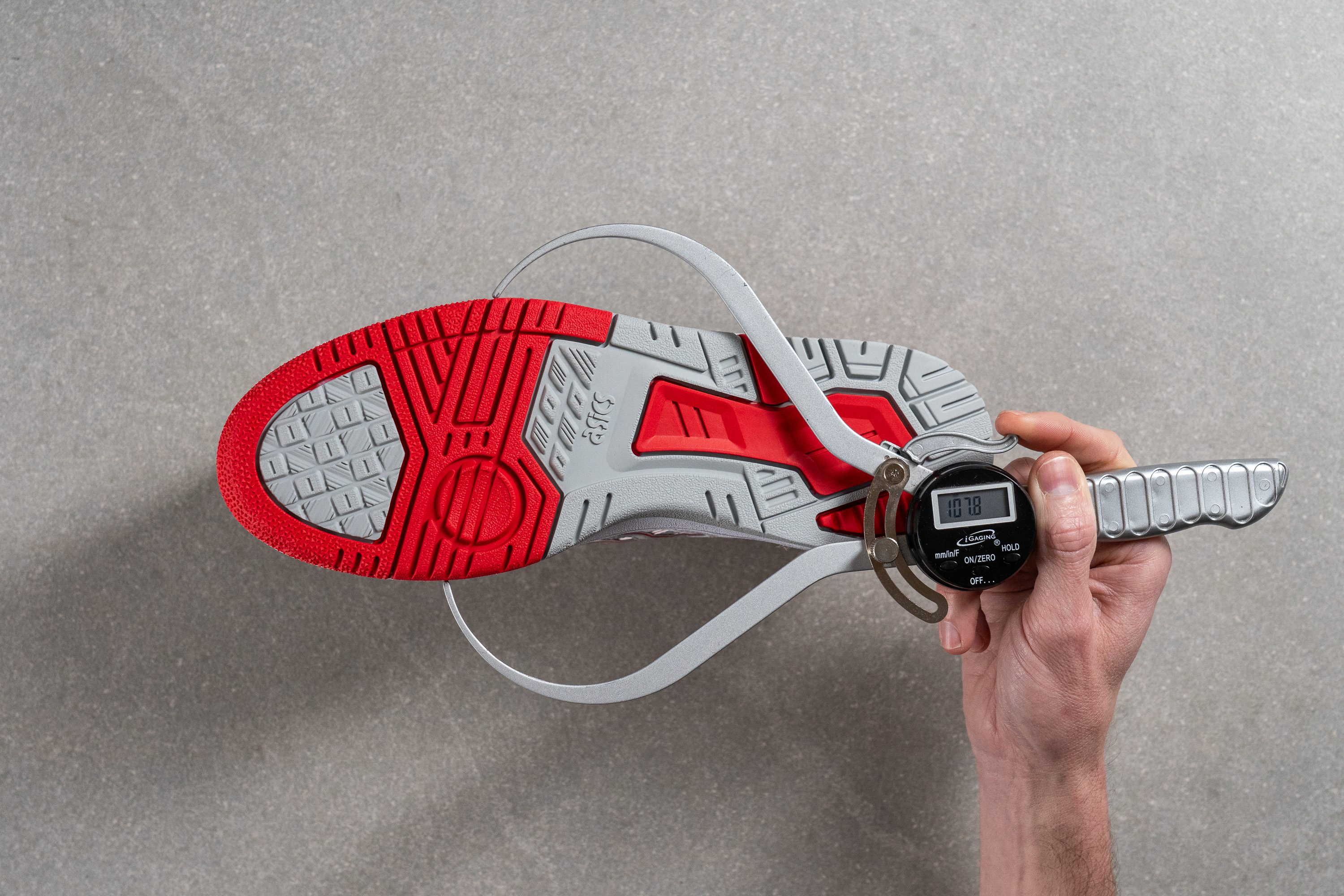
| Asics EX89 | 107.8 mm |
| Average | 108.9 mm |
Midsole width - heel
The midsole is also ever so slightly narrower than our current lab average the heel at 82.2 mm wide according to our caliper. This didn't pose any problems either during testing.
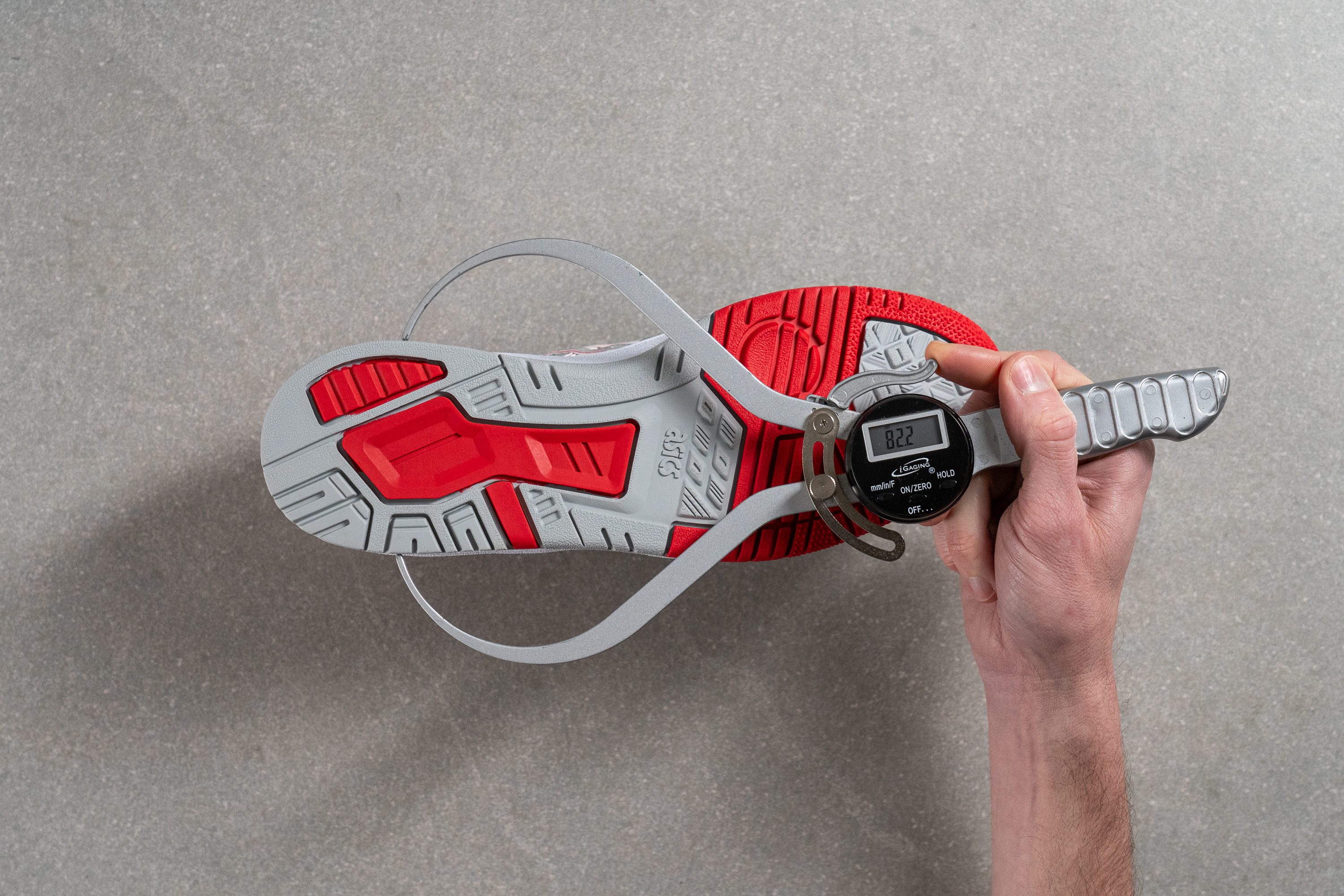
| Asics EX89 | 82.2 mm |
| Average | 84.0 mm |
Durability
Leather/Suede quality
Starting with the colored overlay at the heel, we use a blowtorch to test whether the leather used is genuine. The way it gets scorched and flakes away at the touch of our awl leads us to determine that it is, indeed, genuine leather.
The white overlay next to that reacted similarly. Also real. So far so good.
Last up to face the flame is the toebox, with the same material being used under the other overlays. It, unfortunately, ignites almost immediately and starts melting like the Wicked Witch of the West. Synthetic.
| Asics EX89 | Real leather |
Toebox durability
The EX89's toebox may be synthetic but it's also very tough. We got our Dremel's abrasive element spinning at 5K RPM and set it against the toebox with 3.2N of force.
After twelve seconds of relentless grinding, the sneaker was left looking about as intact as it did before the test began. This excellent performance leads us to give the EX89 a perfect toebox durability score of 5 out of 5. It's going to take a lot more than a few bumps or scrapes to really damage this shoe's upper.

The NB 530's breathable upper mesh, on the other hand, stood no chance against our tool.
| Asics EX89 | 5 |
| Average | 3.7 |
Heel padding durability
The heel collar proved to be just as impervious to our Dremel's destructive disposition.
The lining material successfully fends off the tool's abrasive element and leaves the four-second test almost completely unscathed. This leads us to give the EX89 another perfect durability score of 5 out of 5 for the heel padding. The shoe's performance so far indicates the commendable quality of the materials used in its construction.
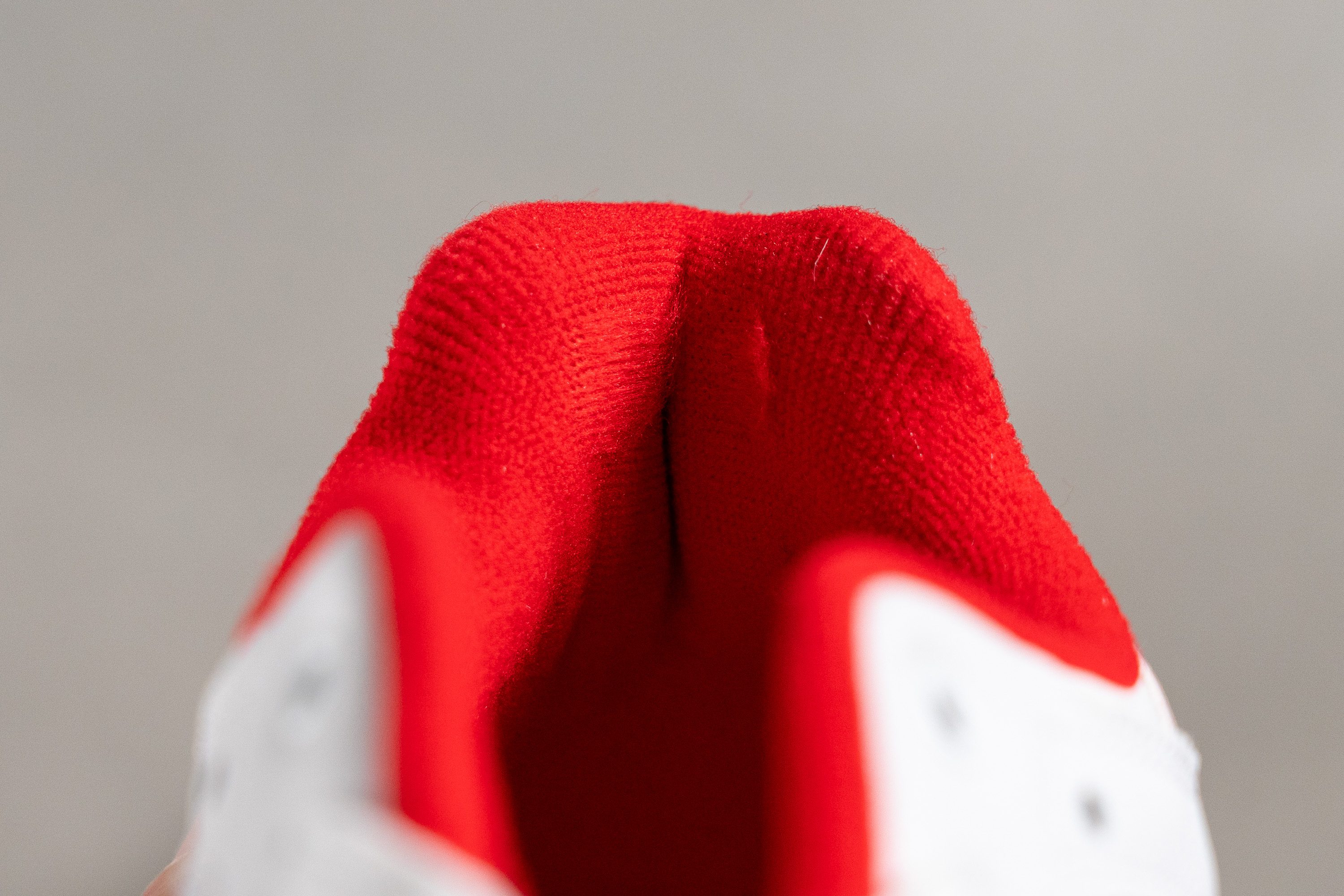
| Asics EX89 | 5 |
| Average | 3.2 |
Outsole hardness
We pressed our durometer against the outsole rubber and got a slightly harder-than-average reading of 90.3 HC. We found that this doesn't negatively affect the shoe's traction, though does give us a bit of a firm landing as it's the first part of the shoe that makes contact with the ground. A harder material also usually indicates better durability, an assumption that we'll be testing next.

| Asics EX89 | 90.3 HC |
| Average | 85.7 HC |
Outsole durability
Firing it up to 10K RPM this time for its last hurrah, we set our Dremel against the EX89's outsole for twenty-two grating seconds.
Once the time was up, we used a tire tread gauge to measure the indentation left in the wake of the test and found that only 0.6 mm of rubber was worn away. This makes the EX89's outsole more durable than average and leads us to predict that this shoe should comfortably last at least 500 miles of use before any significant signs of wear and tear to the tread.
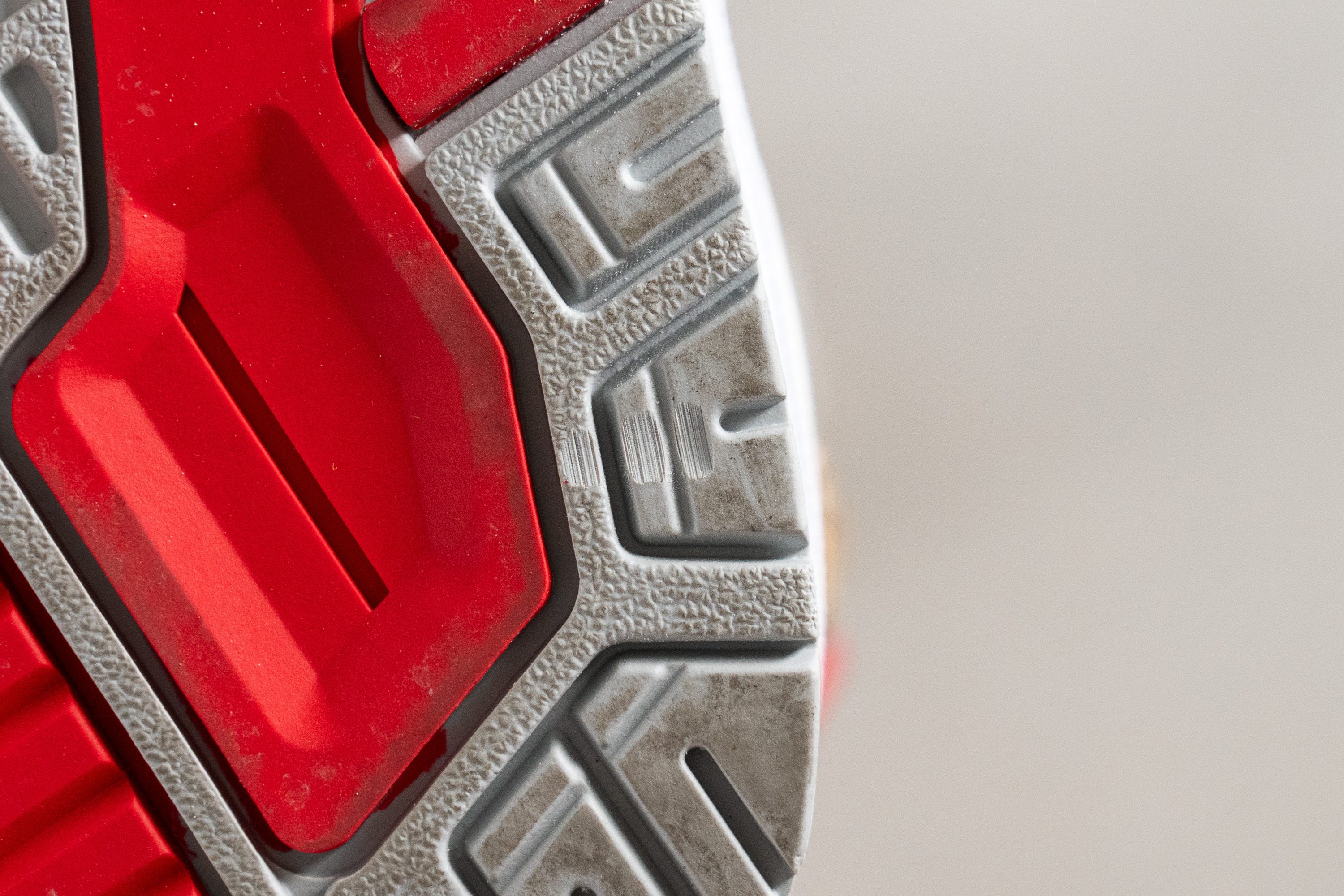
| Asics EX89 | 0.6 mm |
| Average | 1.1 mm |
Outsole thickness
At 5.8 mm thick according to our caliper measurements, the EX89 boasts an average amount of rubber in its outsole. With the rubber proving its mettle in our previous section, this doesn't give us any cause for concern as there's plenty of material for us to wear away over the shoe's lifetime.

| Asics EX89 | 5.8 mm |
| Average | 5.3 mm |
Misc
Insole thickness
Using our caliper, we found the EX89's insole to fall in line with our current lab average at 5.5 mm thick. This gives us a cushy enough footbed within the shoe that provides adequate arch support as we test the shoe.
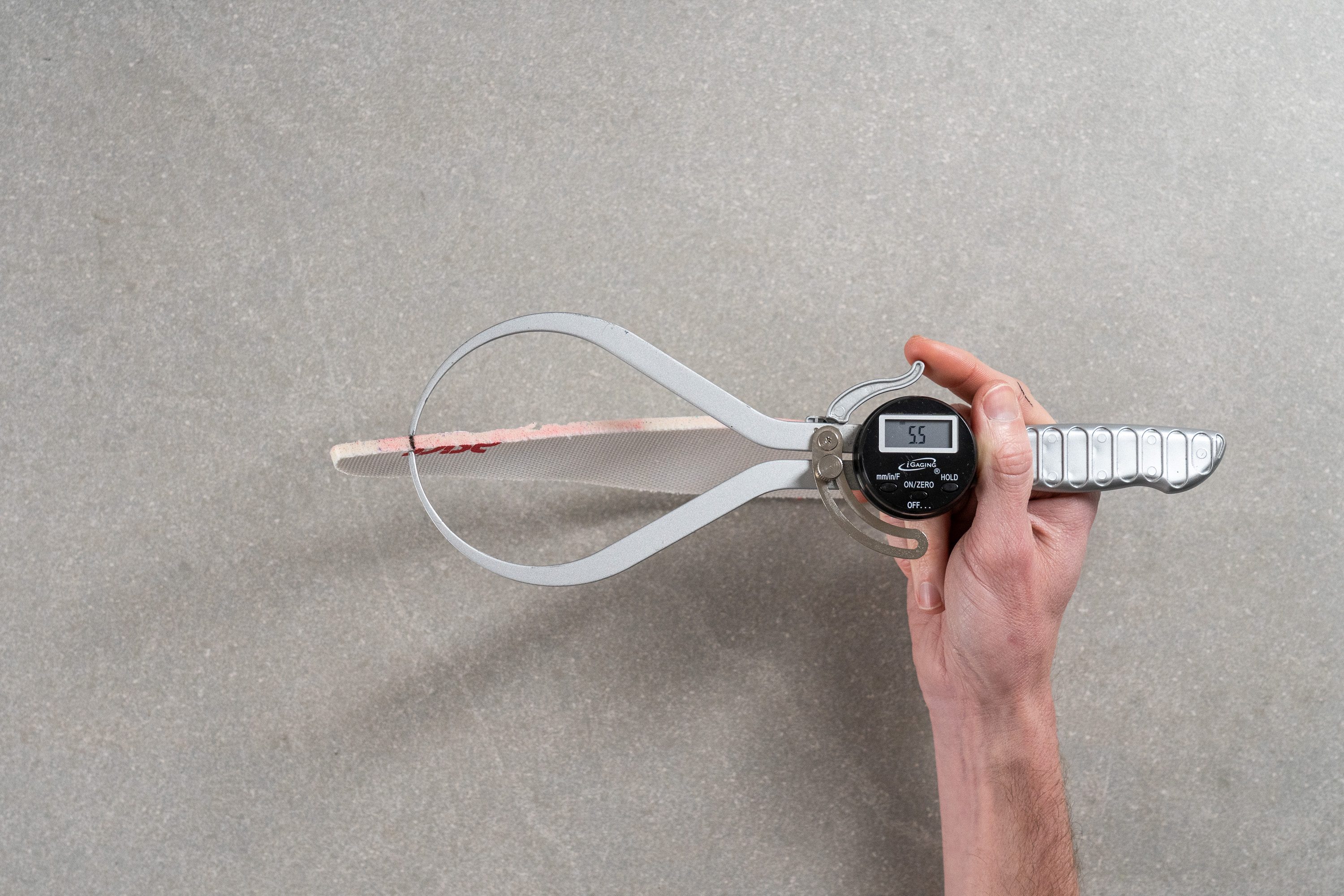
| Asics EX89 | 5.5 mm |
| Average | 5.1 mm |
Removable insole
The EX89's insole is fully removable so replacing it with an aftermarket alternative or a custom orthotic for added arch support is possible if necessary.
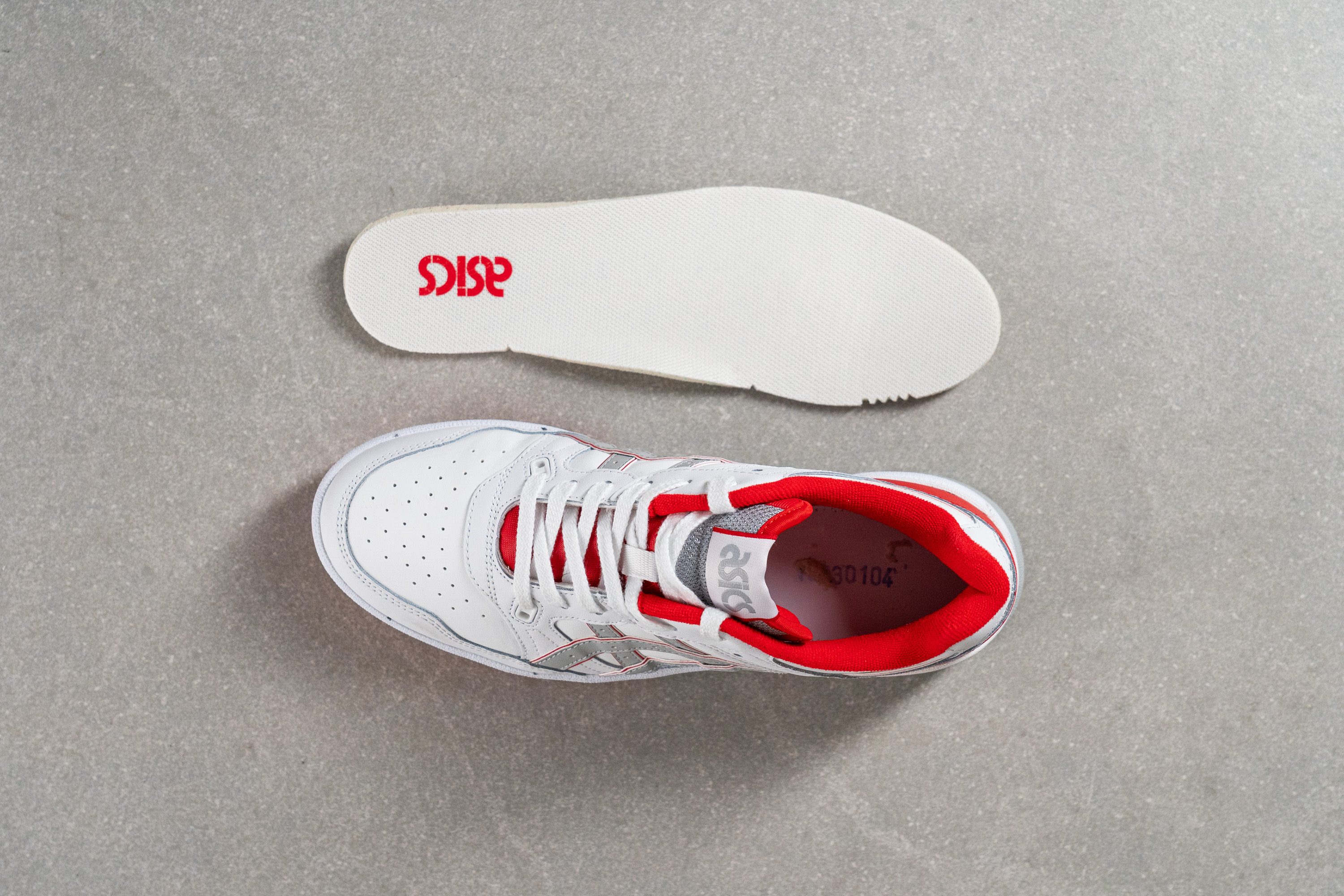
| Asics EX89 | Yes |
Reflective elements
Staying true to its retro vibe, the EX89 doesn't feature any reflective elements for added nighttime visibility.
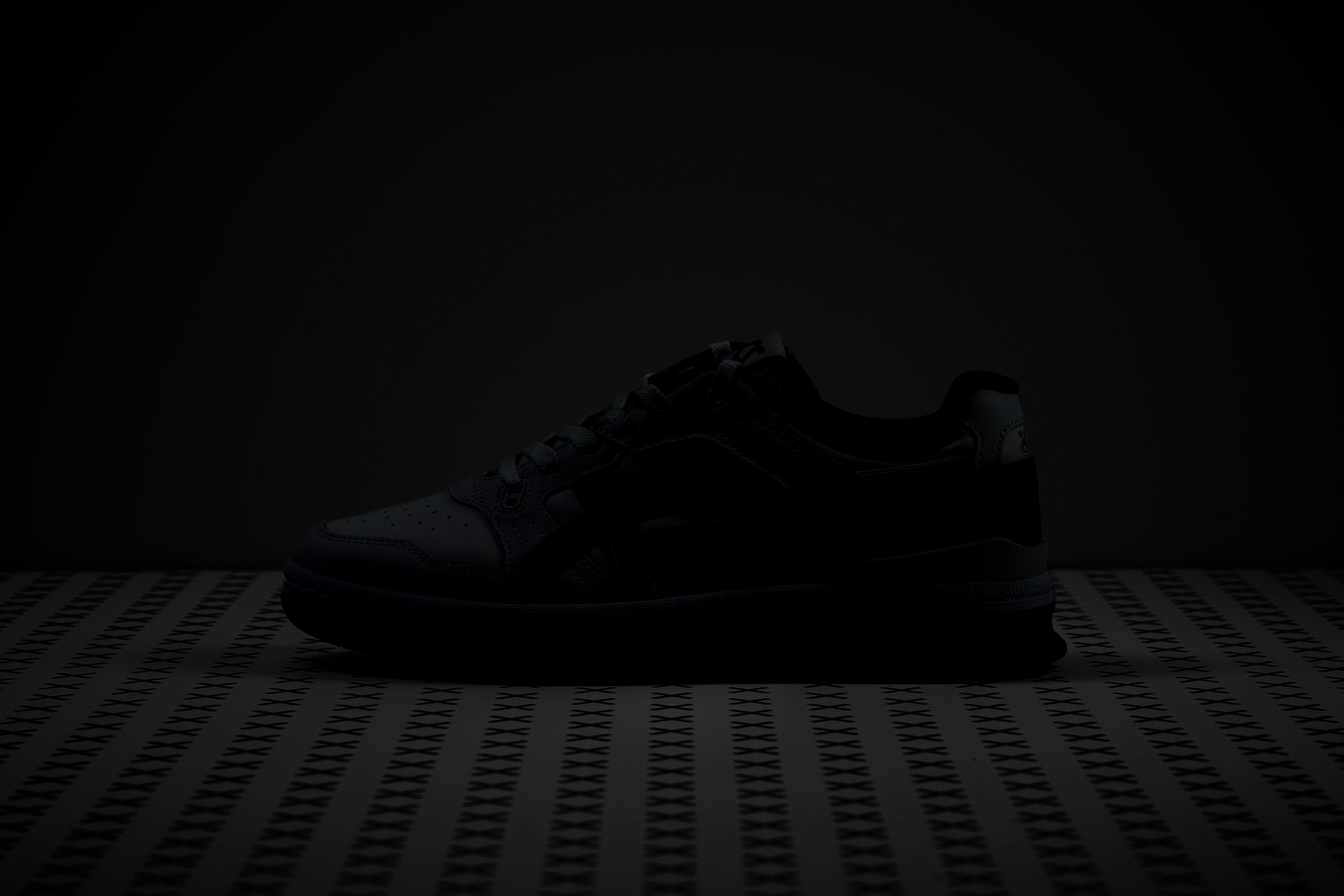
| Asics EX89 | No |
Tongue padding
As alluded to in the previous section, the EX89's tongue is a beast at 12.2 mm thick. This is much thicker than average and means that we were spoiled for comfort around the instep with no hint of lace bite no matter how tightly we cinched the shoe up.
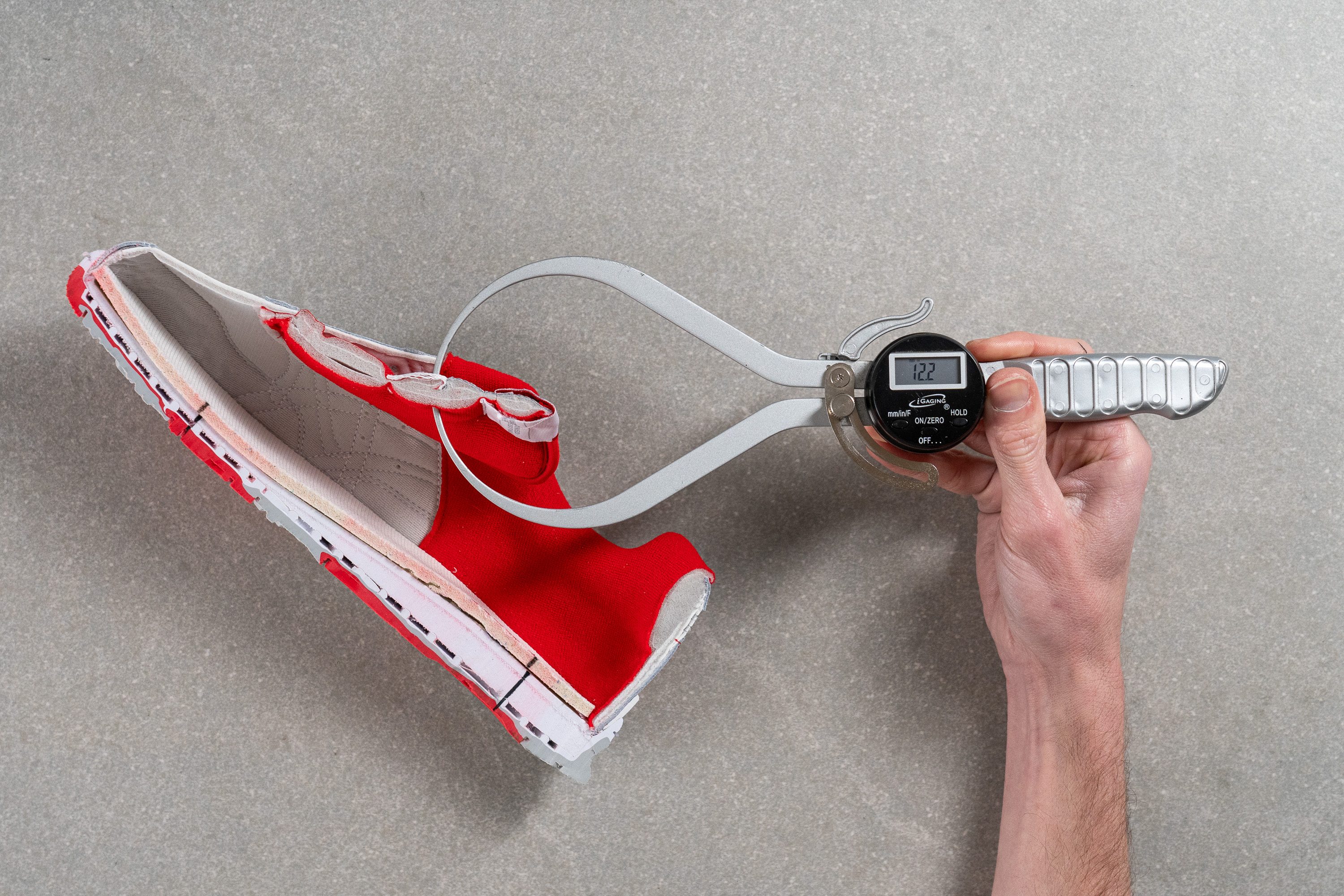
| Asics EX89 | 12.2 mm |
| Average | 9.6 mm |
Tongue: gusset type
The EX89's tongue is non-gusseted, However, its chunkiness and width across our instep, as well as the central lace loop, does effectively mitigate any side-to-side slippage.
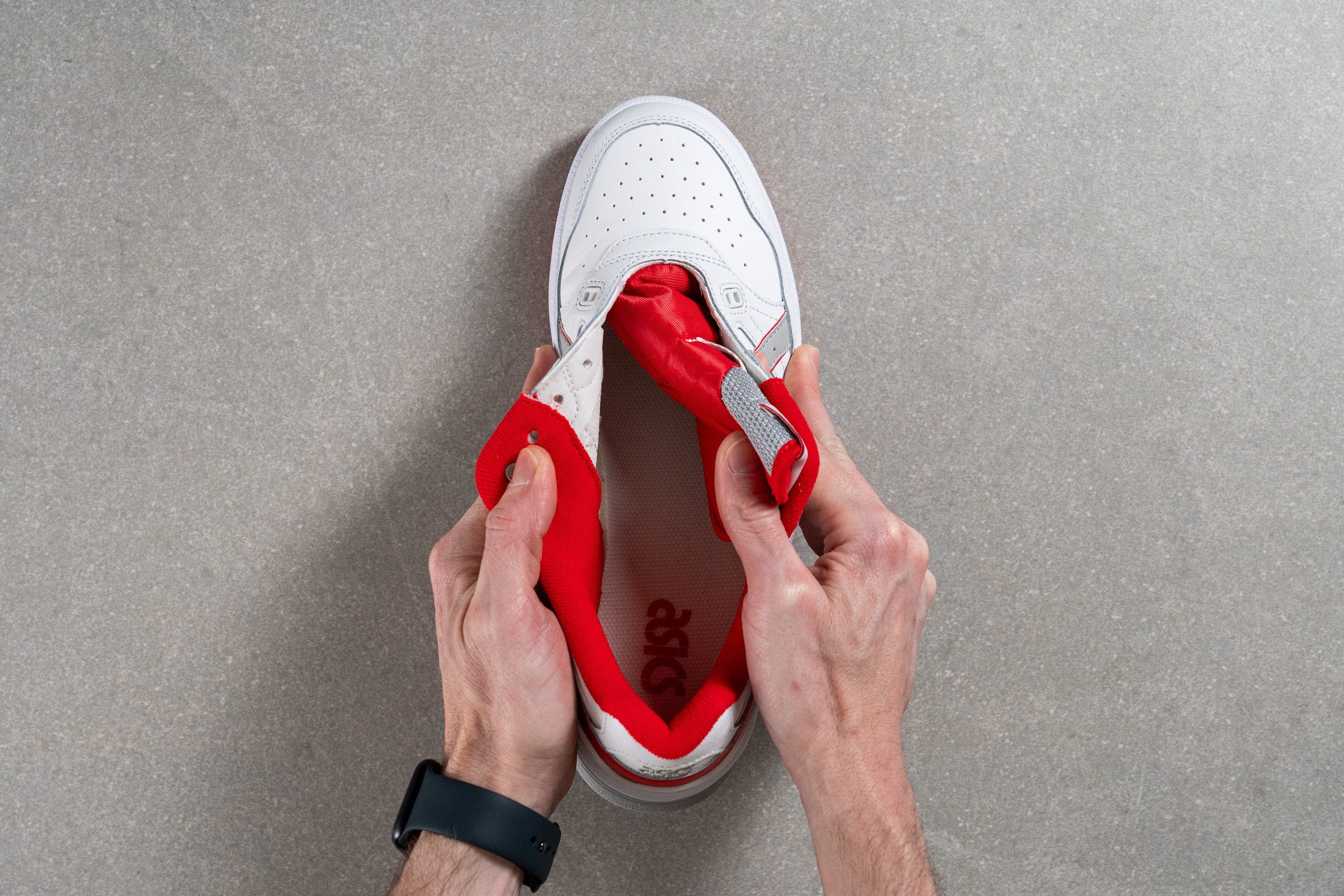
| Asics EX89 | None |
Heel tab
The EX89 doesn't have any loops or tabs, but the on-and-off action is relatively easy.
| Asics EX89 | None |

